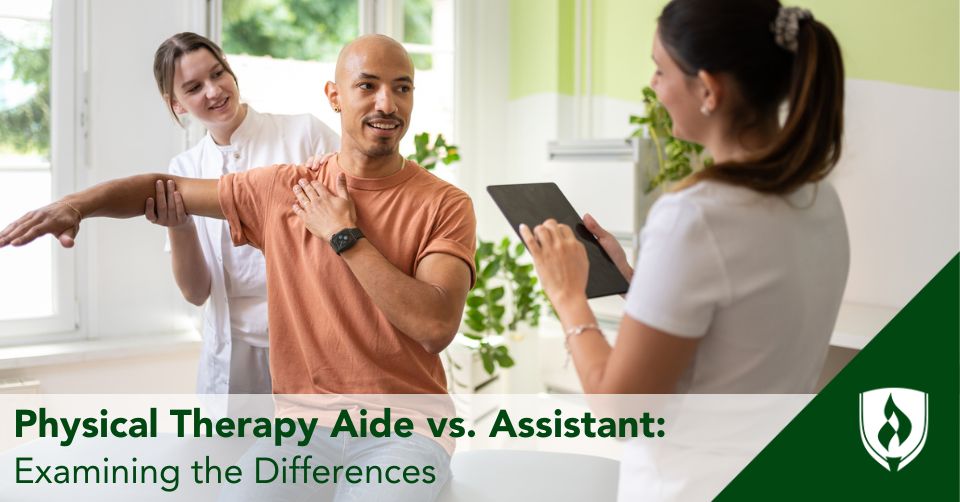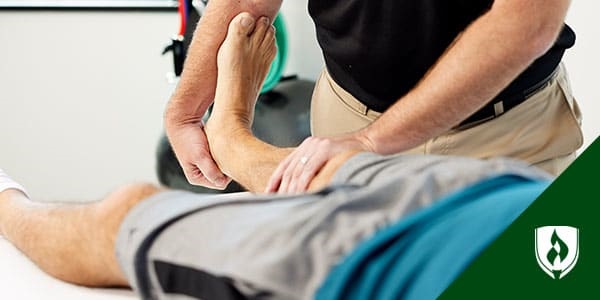
You’ve never pictured yourself working in an office. You need a job that’s about helping people—and that keeps you active while at work, too!
The physical therapy field checks all the boxes above, but you aren’t quite sure which role in physical therapy the right fit for you. When it comes to comparing the roles of physical therapy aide vs. assistant, job titles alone might leave you scratching your head.
How does each professional interact with patients? What do educational requirements look like for each role? Do physical therapist assistants or aides need to pass any licensing exams?
We’re laying out all the details to answer these questions—and more. So, first and foremost, let’s dive into some of the key distinguishing factors that define these career options.
What’s the difference between a physical therapist assistant and aide?
Although both work under a licensed physical therapist, these two roles share little in common. Physical therapist assistants—sometimes called “PTAs”—are directly involved in patients’ treatment. They guide patients through exercises and trainings, following the care plans physical therapists create. Conversely, physical therapy aides have a more “behind-the-scenes” role in patient care.
The Bureau of Labor Statistics (BLS) says physical therapy aides’ responsibilities “vary by state.”1 Still, some common tasks they perform include:
- Cleaning treatment areas
- Setting up physical therapy equipment
- Washing linens
- Helping move patients to and from the therapy area
- Performing clerical tasks, including answering phone calls and scheduling patient appointments1
Together, assistants and aides are invaluable staff among physical therapy offices. As you might suspect, however, their contrasting responsibilities call for very different educational requirements.
According to the BLS, becoming a physical therapy aide requires only a high school diploma (or equivalent), along with on-the-job training.2
Because physical therapist assistants have a more active role in patient care, though, these professionals must complete postsecondary education.
“All states require physical therapist assistants to have an associate’s degree from a program accredited by the Commission on Accreditation in Physical Therapy Education®,” states the BLS.2
Physical therapy assistants are also required to be licensed or certified in every state. So, in addition to completing an associate’s degree, aspiring PTAs must pass the National Physical Therapy Examination (NPTE®) to obtain licensure as, the BLS explains.2
With that extra training, physical therapist assistants have a wider range of activities they handle.
What are a physical therapist assistant’s main responsibilities?
Physical therapist assistants work under the supervision of physical therapists to help patients progress through their care plans. PTAs use physical therapy techniques such as stretching, exercises, special equipment and massage to directly help patients regain mobility.
PTAs work closely with physical therapists, making sure they stick to each patient’s care plan and report health updates to the physical therapist. “A PTA can perform manual therapy on patients, as well as oversee exercises as long as they are in contact with a PT and have a PT overseeing the patient's case,” says Dr. Elizabeth Alice Kerby, physical therapist at the Kerby Method.
Most PTAs work in hospitals or clinics that specialize in physical therapy. Some also work in assisted living facilities or visit patients in their homes as part of a home healthcare service. Regardless of their exact work setting, physical therapist assistants enjoy an active career that keeps them on their feet for much of the day.
What are a physical therapy aide’s main responsibilities?
Like PTAs, physical therapist aides work in hospitals or physical therapy clinics as part of the team that helps PTs offer high-quality care to their patients. Instead of providing direct patient care, however, their job duties revolve around keeping the clinic organized and running smoothly.
Laws differ from state to state, but physical therapy aides generally handle basic clerical duties like scheduling, cleaning and setting up equipment and helping patients get to and from their therapy areas. “A PT aide is unable to perform manual skills or other forms of patient care,” Dr. Kerby says.
Physical therapist aides may not be involved in as much direct patient care as physical therapist assistants, but they’re still an essential part of this healthcare field. Their work ensures that the physical therapy environment is clean and ready for incoming patients and that physical therapists have everything they need to carry out a patient’s care plan.
Physical therapist assistant vs. physical therapy aide: Job outlook
Both careers offer positive job outlook projections, largely due to the Baby Boomer generation approaching an age that comes with mobility-related health issues. Physical therapist assistant and aide jobs are projected to grow by 19 percent between 2022 and 2032, according to the Bureau of Labor Statistics.3
This is much faster than the projected national average across all occupations!
Physical therapist assistant vs. physical therapy aide: Which career is right for you?
There are lots of factors to weigh as you evaluate these physical therapy career options. We can’t tell you which career is right for you, but we can offer some parting advice.
If it’s a priority to get your new career off the ground immediately, physical therapy aide might be the right choice for you. Dr. Kerby also notes that this is a path to consider for someone who enjoys organizing, cleaning and clerical tasks.
But if you don’t mind some extra schooling and are interested in having more autonomy in working with patients, physical therapist assistant might be the better job title for you. And while many Associate’s degrees take two years to complete, the Rasmussen University Physical Therapist Assistant Associate’s degree program can be completed in as few as 18 months.4
“For someone who is interested in more direct patient care, the role of a PTA will be a more satisfying fit,” Dr. Kerby says.
Still feeling stuck? Dr. Kerby suggests getting started in the field as a physical therapy aide while working on your Associate’s degree to become a physical therapist assistant. “This is a great way to gain an introduction to the field and make connections.”
Which physical therapy career will you choose?
When it comes to physical therapist assistants versus physical therapy aides, there are a lot more differences than you may have expected! Now that you know the ins and outs of each role, you can start to think about which career is right for you.
If the direct patient care of a physical therapist assistant career sounds right up your alley, get started today by learning more about the Rasmussen University Physical Therapist Assistant Associate’s degree program!
Related Articles:
NPTE® is a registered trademark of Federation of State Boards of Physical Therapy
Commission on Accreditation in Physical Therapy Education® is a registered trademark of American Physical Therapy Association
1Bureau of Labor Statistics, U.S. Department of Labor, Occupational Outlook Handbook, Physical Therapist Assistants and Aides, (accessed April 2024), Physical Therapist Assistants and Aides : Occupational Outlook Handbook: : U.S. Bureau of Labor Statistics (bls.gov)
2Bureau of Labor Statistics, U.S. Department of Labor, Occupational Outlook Handbook, Physical Therapist Assistants and Aides, (accessed April 2024), Physical Therapist Assistants and Aides : Occupational Outlook Handbook: : U.S. Bureau of Labor Statistics (bls.gov)
3Bureau of Labor Statistics, U.S. Department of Labor, Occupational Outlook Handbook, Physical Therapist Assistants and Aides
4Completion time is dependent on the number of courses completed each term and the number of transfer credits accepted.




